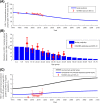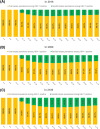Characterizing the transitioning epidemiology of herpes simplex virus type 1 in the USA: model-based predictions
- PMID: 30853029
- PMCID: PMC6410528
- DOI: 10.1186/s12916-019-1285-x
Characterizing the transitioning epidemiology of herpes simplex virus type 1 in the USA: model-based predictions
Abstract
Background: Herpes simplex virus type 1 (HSV-1) is a prevalent lifelong infection that appears to be undergoing an epidemiologic transition in the United States (US). Using an analytical approach, this study aimed to characterize HSV-1 transitioning epidemiology and estimate its epidemiologic indicators, past, present, and future.
Methods: An age-structured mathematical model was developed to describe HSV-1 transmission through oral and sexual modes of transmission. The model was fitted to the National Health and Nutrition Examination Surveys, 1976-2016 data series.
Results: HSV-1 seroprevalence was projected to decline from 61.5% in 1970 to 54.8% in 2018, 48.5% in 2050, and 42.0% in 2100. In < 3 decades, seroprevalence declined by > 30% for those aged 0-19 years, but < 5% for those aged > 60. Meanwhile, the number of new infections per year (oral and genital) was persistent at 2,762,000 in 1970, 2,941,000 in 2018, 2,933,000 in 2050, and 2,960,000 in 2100. Of this total, genital acquisitions contributed 252,000 infections in 1970, 410,000 in 2018, 478,000 in 2050, and 440,000 in 2100-a quarter of which are symptomatic with clinical manifestations. For those aged 15-49 years, nearly 25% of incident infections are genital. Most genital acquisitions (> 85%) were due to oral-to-genital transmission through oral sex, as opposed to genital-to-genital transmission through sexual intercourse.
Conclusion: HSV-1 epidemiology is undergoing a remarkable transition in the US, with less exposure in childhood and more in adulthood, and less oral but more genital acquisition. HSV-1 will persist as a widely prevalent infection, with ever-increasing genital disease burden.
Keywords: Genital herpes; Herpes simplex virus type 1; Incidence; Mathematical model; Oral herpes; Prevalence; United States.
Conflict of interest statement
Ethics approval and consent to participate
Not applicable.
Consent for publication
Not applicable.
Competing interests
The authors declare that they have no competing interests.
Publisher’s Note
Springer Nature remains neutral with regard to jurisdictional claims in published maps and institutional affiliations.
Figures






References
Publication types
MeSH terms
LinkOut - more resources
Full Text Sources
Medical
Miscellaneous

